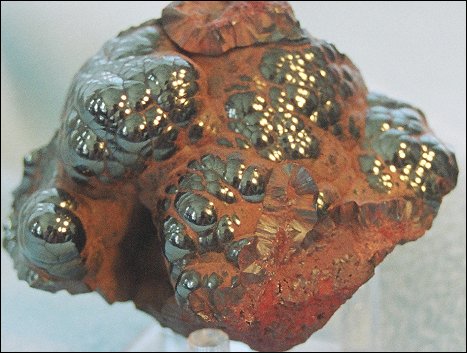| The Chemistry of Paints and Painting is a free textbook on chemical aspects of painting. See the editorial for more information.... |

|

Home  Pigments Pigments  Red Pigments Red Pigments  Red Ochre Red Ochre |
|||||






|
|||||
|
Red Ochre
The pigments above-named are native ferric oxide (or iron peroxide) associated with variable proportions of mineral impurities such as clay, chalk, and silica. They differ from the yellow and brown ochres described on page 157, by not containing combined water, in other words, the iron to which they owe their colour is ferric oxide, not ferric hydrate, except in the case of turgite, named on page 202. They occur in very many localities accompanying or even constituting some of the most important iron ores. Their colour varies with their physical state, and with their purity; some are iron grey, or even black, until they are finely ground, when they assume a cherry-red hue. Cappadocia yielded to the ancient Greeks some at least of their sinopis, or red ochre, but they were familiar with the process of calcining yellow ochre in order to redden its hue; and they thus prepared the pigment to which the name 'light red' is now assigned.
An unusually bright red variety of hematite from Cumberland gave me on analysis, in 100 parts, ferric oxide, 94.7; alumina, 2.0; silica, 2.2, and moisture, 1.1. But some almost equally rich red ochres contain much less iron oxide, a 'sinopis' from Anatolia, analysed by Klaproth, having been found to contain 21 percent only, and others, from other localities, not above 40. The paler varieties of a reddish brown or yellow brown hue often consist of mixtures of hematite and yellow ochre. A very fine red ochre from Tuscany, the Banat, Hungary, and from the Urals, contains about 5 percent of water, and is considered to belong to a distinct mineral species called turgite, as mentioned before under the heading 'Venetian Red.' When red chalk (from Hunstanton, Norfolk) is calcined at a high temperature it loses its red colour, and becomes of a dull olive green hue, a change due in this case to the production of calcium ferrite, a compound of lime and ferric oxide. The terra rosa of Italy owes its pinkish red hue to ferric oxide, but it is probably often, if not always, an artificial product. All the pigments described under the title 'red ochre' are permanent, and without action on other pigments. For the substitution of artificially prepared ferric oxide, or colcothar, for red ochre, and for the method of detecting it, reference should be made to page 202, under 'Indian red.'
|
|||||
Home  Pigments Pigments  Red Pigments Red Pigments  Red Ochre Red Ochre |
|||||
Last Update: 2011-01-23


